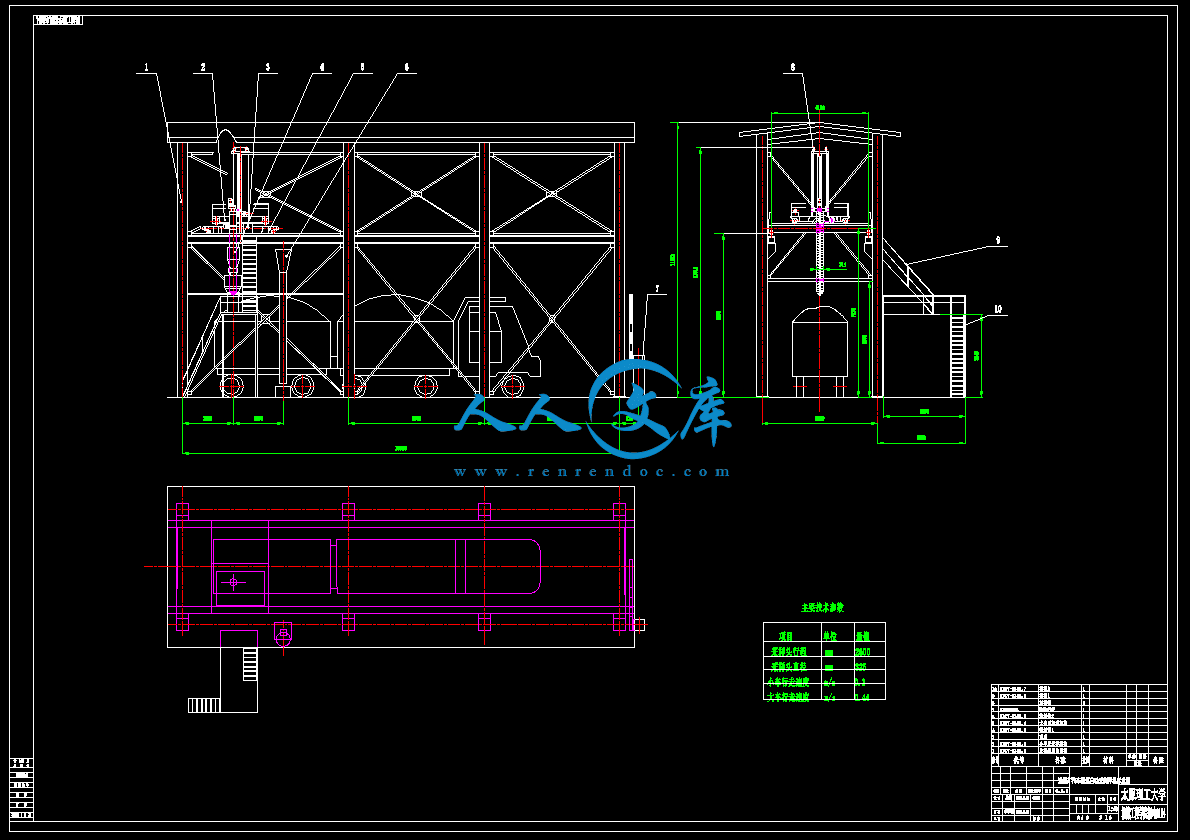车运原煤自动采样控制系统设计
46页 23000字数+说明书+外文翻译+1张CAD图纸
外文翻译--选煤概述和煤的可选性.doc
摘要.doc
汽车采样梯形图.cxp
装配图.dwg
装配图.exb
车运原煤自动采样控制系统设计说明书.doc
车运原煤自动采样系统设计
(控制系统设计)
摘要
论文阐述了可编程控制器PLC在车运原煤自动采样系统中的应用。主要介绍了车运原煤自动采样的PLC控制系统总体方案设计,设计出了硬件控制电路、软件程序梯形图
及指令表,并给出了系统组成框图和程序流程图。
我设计的是对汽车所运原煤进行采样的自动小车控制系统,实现小车的横向、大车的纵向移动以及采样螺旋探头的上升、下降过程。系统采用可编程控制器控制。
采样工作过程如下:
当载运车辆到达采样点时,人工启动采样系统,采样小车先横向运行指定时间后停止,然后大车进行纵向运行,到指定位置时停止,螺旋采样筒旋转,采样头下降并旋转进入汽车煤层,到达一定深度后稍做停留,将车载原煤载入采样筒上方的采样斗中;然后采样头上升,大车小车后退回原位,采样头料门打开,煤样流入料斗,取样完成。
入厂原煤采制样装置是洗煤厂入厂原煤质量分析中的重要设备。利用可编程序控制器,实现对入厂原煤采制样装置的自动控制,不仅简化了操作,而且提高了系统的可靠性。
关键词∶ 可编程控制器;采样系统;自动控制
Abstract
The thesis elaborated the programmable controller PLC in car carry automatic sampling system of raw coal of application. The thesis mainly introduced the total project design of PLC control system that the car luck raw coal automatically sample, design the hardware control electric circuit, software procedure trapezoid chart
And the instruction gage, and give the system composition block diagram and the procedure flow chart.
What I design is an automatic and small car control system that samples to the autocar raw coal progress carry, carry out the small car of transversal and big car travel and sample the rising that screw stretch forward and descend the process lengthways. The system adopts the programmable controller control.
Sampled the process of operate as follows:
When transport the vehicle to arrive the sampling spot, the artificial start sampling system, sample the small car to traverse the running first to stop after specify time, then the big car progress circulates lengthways, while arriving to specify the place stop, the screw sampling tube revolution, sample the prinipal to descend and revolve into the coal seam, coalbed of autocar , make to stop over slightly after arriving the certain depth, carry car the sampling bucket that the raw coal loads in to sample on the above of the tube. Then sample the rising of prinipal, the small car of big car recoil to return to home position, sampling the prinipal to anticipate the door to open, the coal sample flows in to anticipate the bucket, the sampling complete.
Go into the raw coal of plant adopts to make the kind apparatus is important equipments that washes the coal plant to go into the plant raw coal mass analysis. Make use of the programmable preface controller, carry out to adopt the automatic control of make the kind apparatus towards going into the raw coal of plant, not only simplified the operation, but also raised the system reliability.
Key words: Programmable Logic Controller ;Sample system ;Automatic control
目 录
摘要………………………………………………………………………………… ⅰ
Abstract…………………………………………………………………………… ⅱ
目录………………………………………………………………………………… ⅲ
绪论………………………………………………………………………………… 1
第一章 车运原煤自动采样系统总体方案设计 ………………………………… 2
一、总体方案确定…………………………………………………………… 2
二、设计采制样装置及其主要设备………………………………………… 7
第二章 车运原煤自动采样控制系统设计 ……………………………………… 11
一、采制样装置的PLC控制系统组成 …………………………………… 11
二、PLC 的工作原理和结构组成…………………………………………… 11
三、PLC 的选择……………………………………………………………… 15
四、CPU 模块型式及电源模块型式规格选择……………………………… 20
五、变频器的选型…………………………………………………………… 22
第三章 车运原煤自动采样软件系统的设计 …………………………………… 28
一、建立I/O地址分配表…………………………………………………… 28
二、端子接线图……………………………………………………………… 29
三、程序流程图……………………………………………………………… 29
四、PLC 程序设计 ………………………………………………………… 31
五、PLC 控制系统抗干扰能力……………………………………………… 38
结论………………………………………………………………………………… 41
致谢………………………………………………………………………………… 42
参考文献…………………………………………………………………………… 43
附录………………………………………………………………………………… 44
一、英文资料及中文翻译………………………………………………………… 44
二、梯形图………………………………………………………………………… 59
一、本论文研究的目的和意义
随着计算机技术的飞速发展,计算机在工业自动化领域中的应用越来越广泛。可编程控制器就是其中的佼佼者,它以其卓越的性能,高可靠性、能在恶劣环境下工作、维修使用方便、通讯、组网功能强和具有较高的性价比等特点,被广泛的应用于工业控制中。
火力发电厂、港口和煤矿等部门都要对出入煤的质量进行分析,分析检验结果作为生产成本核算、控制锅炉工况或作为商品煤结算的依据。煤的质量分析包括采集样品(采样) 、制备试样、分析。用少量的样品的分析结果代表一批煤的质量必然会有偏差。此偏差由采样偏差、制样偏差和分析偏差构成,其中采样偏差最大。因此,分析结果的精确度,很大程度上取决于所采样品的代表性。以前靠人工采样,很难保证样品的代表性。分析偏差太大时还可以重新分析,而样品无代表性时,则往往由于煤已运走或已入锅炉烧掉而无法重新采样。如果煤样品无代表性,则无论分析结果多么精确也毫无意义。国家标准GB474 规定了各种情况下煤的采样方法。在流动的煤(煤流) 中采样时,应将采样处煤流横截面上的煤全部采出。
汽车入厂煤采样机是针对运煤汽车采样而设计的机械化采样设备。该设备集采样、破碎、缩分、集样于一体、结构合理、运行可靠、操作方便。采样制样工艺过程符合GB474,GB475国家标准。适用于电厂、煤矿、煤码头等进行煤质检验采样的场合。
汽车入厂煤采样机主要由采样头、给料机、破碎机、缩分集样器、余煤处理系统组成。首先由钻取式螺旋采样头提取煤样,通过密闭式给料机送放破碎机、破碎后进入缩分集样器,通过缩分的煤样进入集样器,多余的煤样由余煤处理系统反排回汽车或直接排回煤场。
采用本采样系统的优点有:
(1).可实现全断面采样,保证煤样代表性;
(2).采用专利破碎机,水份适用范围广,减少堵煤可能性;
(3).一体化设计,结构紧凑,采样时间短;
(4).半封闭结构,减少人为与环境因素的影响;
(5).设备自动化程度高,维护简单。
通过本设计可以使整个系统不易堵煤、监测系统更加趋于完善,程控特性更好,且易于安装和维护。
二、论文研究的主要内容
设计对汽车所运原煤进行采样的自动小车控制系统,实现小车的横向、大车的纵向移动以及采样螺旋探头的上升、下降过程。系统采用可编程控制器进行控制。
具体内容如下:
1 车运原煤自动采样系统总体方案设计;
2 车运原煤自动采样控制系统设计;
3 设计控制系统硬件,包括控制器选型设计和控制接线图;
4 控制系统软件设计,包括程序流程图和系统控制软件。
第一章 车运原煤自动采样系统总体方案设计
车运原煤自动采样系统总体方案的设计应包括以下内容:采制样装置结构型式的确定,采制样装置基本组成、采制样装置工作原理、采制样装置主要设备的技术参数及机构的选择等内容。
一般应根据设计任务和要求提出数个总体方案,进行综合分析、比较和论证,最后确定一个可行的总体方案。
一、总体方案确定
(一)概述
煤的计量及其机械自动采制样是火力发电厂实现计算煤耗的前提,电力部颁布的《火力发电厂按入炉煤量正平衡计算发电煤耗(试行)》中指出 “机械自动采样装置是目前唯一能够采到具有代表性样品的手段”。
入厂煤机械自动采制样装置中机械结构设计新型实用,整体结构布局通畅,选取的技术参数合理,工艺调节方便,适应范围广。适用于火力发电厂的入厂煤采样及其它类似场合。机械可长期稳定运转,不堵煤,采样后的子样代表性强,满足现场实际需要。该装置作为现代化采制样设备,可为电厂,煤矿等有关单位提供煤质检测和监督的可靠依据,并且有助于燃煤管理的科学化和规范化。
电气控制部分采用目前国际上流行的可编程控制器作为主控元件,在设计思想上力求与国际接轨。因此,可靠性显著增强,控制性能大为提高,而且具有智能化的优点。
该设备采样技术及工艺过程完全符合《GB475-96商品煤样采取方法》的规定,制样方案完全符合《GB474-96煤样的制备方法》

 川公网安备: 51019002004831号
川公网安备: 51019002004831号